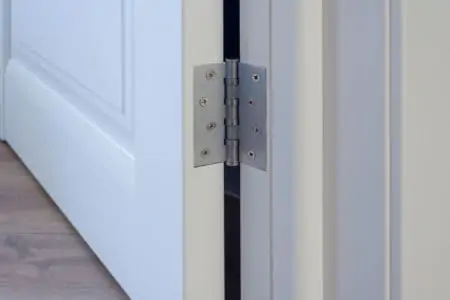Knowing how to hang a door is crucial if you want the door to be plumb, and open and close correctly. Even if it takes you all day to complete, it’s worth going slow to get it right.
We show you the best technique for hanging exterior and interior doors and share tips to help you get the best results.
Key Takeaways
- Gather tools and materials, like a spirit level, drill, tape measure, and wood shims.
- Measure the door opening and shim space, ensuring a 0.125-inch gap for standard doors.
- Attach hinges to the door first, then line them up with the frame and secure them in place.
- Check that the door swings freely and closes correctly before attaching the door hardware.
How Hard Is It to Hang Doors?
Hanging an interior door may seem like a daunting task, but with a bit of practice, even a novice can do it. It may take all day, but you can work on your speed once you’ve mastered the correct technique.
The secret to success is working methodically and continually checking that the door is level.
How to Hang a Door Yourself
Hanging interior and exterior doors is a skill that will serve you well time and again. But we all have to start somewhere. Before you begin, you will need the correct tools and materials.
What You’ll Need
- Spirit level.
- Assorted drill bits.
- Drill.
- Square.
- Hammer.
- Handsaw.
- Tape measure.
- Utility knife.
- Three-inch wood screws.
- Lengths of 2×4.
- Wood shims.
- Latch template.
- Foam Filler.
In a New Frame
1. Shim First
A shim is a thin tapered piece of wood used to adjust the door frame to make it square. Most standard openings allow for 0.5 inches of shimming on either side of the frame.
Measure the width of the rough opening first to see how much shim space is available. Mark the hinge locations on the drywall, and place shims at the top and bottom hinge locations.
Most internal doors have hinges set at seven inches from the top of the door and nine inches from the base.
Next, add the center shims using the spirit level to level them out. It’s easier to shim the hinge side of the rough opening before inserting the jamb. When you fit the frame, all you do is nail the hinge side to the shims before shimming and nailing the latch side.
2. Bottom Door Clearance
Your door needs to clear rugs, carpets, and other floor coverings. Screw a plywood strip to the bottom of the rough opening. This ensures that the door has the clearance to pass over floor coverings.
You will need at least 0.5 inches of space between the bottom slab of the door and the rug or carpet.
3. Set the Height of the Door Jamb
Use 0.5-inch thick scraps of wood to rest under the base of the door jamb. It raises it off the rough opening and prevents awkward trimming further down the line.
4. Check the Wall is Plumb
Place the spirit level against the wall and check it is level. If not, you will need a sled hammer and a scrap of wood. Place the wood against the base of the wall and give it a firm tap with the hammer.
Recheck the wall with the spirit level to ensure it is plumb. Do this on both sides of the door opening.
5. Fit the Frame
Screw the hinge-side jamb to the door stud. Insert screws through the frame directly into the shims. To get the right height and ground clearance, ensure the frame is still balanced on the 0.5-inch wood scraps.
6. Shim the Latch Side
Insert the shims on the base and latch side of the jamb. Four shims should be plenty. Drive two finish nails into each shim to secure the frame. Use the utility knife to remove any excess on the shims so that they sit flush with the jamb.
6. Level the Base
Lay the spirit level on the base and use shims to find the level. Keep doing this until the bubble on the spirit level is centered. The distance between the level and the floor tells you how much you need to cut off the jamb if it needs adjusting.
7. Cut the Hinge Mortise
Draw around the hinge plate as a template. Use the utility knife to score along the edges and grab the hammer and chisel. Start by removing a small amount of wood, checking the depth regularly.
Place the hinge in the mortise to see if it sits flush. Use the drill to make pilot holes for the screws. Attach the hinge with the screws provided.
Hold the door in the frame, using wedges to level it up. Get some help with this, as it is tricky to hold the door while measuring.
Check that the latch side of the door is even using the tape measure. You are looking for a 0.125-inch gap from top to bottom.
Mark the center of the hinge with the frame and repeat the same process for cutting the mortices. Attach the hinges to the jamb, and the door is now fixed in place.
8. Check the Door
Ensure the door swings freely and closes as it should. The final step is to attach the door hardware.
9. Attach the Door Hardware
The easiest way to find the correct location of the handle and latch is to use a lock template kit like this DEWALT Door Lock Installation Kit.
With the template as a guide, use the two-inch hole saw to cut the handle hole. Then swap to a one-inch hole saw and drill through the edge of the door in the center of the lock rail. Insert the latch mechanism, feed the metal bar through, and attach both handles.
The final task is to line up the strike plate with the latch and attach it to the door frame. Close the door to see if it latches.
In an Existing Frame
Fitting a door without a frame is easier because you already have the opening size and the old door to use as a guide. You also don’t need to level the frame with shims. Installation should be as simple as swapping like for like.
1. Measure the Opening/or the Old Door
To measure the opening, run the tape measure along the base of the opening to get the width. Do this in the center and at the top and use the smallest measurement as the guide. Repeat this for the length.
Alternatively, measure the old door and copy down the dimensions. Most exterior doors measure 80 inches in length and 34 or 36 inches in width.
2. Check the Old Frame Is Square
It’s not uncommon for door frames to be slightly out of square in old houses. Use a square to check both top corners.
3. Choose the Right Door
Your new door should be 0.125 inches shorter than the finished opening. Any larger, and it will struggle to fit the gap. You could trim the door to size using a sander and plane, but it is much easier to buy one that fits.
4. Check the Door Fits
Place the door in the opening to see if it fits. You may want to enlist some help for this. Butt the hinge side of the door against the frame and mark the location of the hinges.
Use the tape measure to check the top and bottom of the door to ensure there is a 0.125-inch gap on the latch side of the door.
Top Tip
Use wooden supports to level the door and hold it in place before the hinges are attached.
5. Cut the Mortise for the Hinges
Because you are placing a new door in the old frame, you already have the mortise locations for the hinges in the jamb. As you’ve marked the hinge locations on the new door, it’s time to make the mortise.
Lay the hinge plate on the door and draw around it as a template. Grab the utility knife and score along the lines of the hinge. Remove the wood with the hammer and chisel to the depth of the hinge plate.
Lay the hinge in the mortise and drill pilot holes before inserting the screws. This ensures the wood doesn’t split. Now tighten the screws with the screwdriver and repeat the process for the other hinges.
6. Hang the Door
Use your friend to help lift the door into the opening and screw the hinge plates to the hinge jamb. Do this for the other hinges, and the door is now attached.
7. Attach the Handle, Latch, and Strike Plate
To do this, follow step 10 in the previous section. Check that the door swings freely and it closes with ease.
Hanging a Pre-Hung Door
Pre-hung doors come mounted in the frame with hinges attached. It means you can skip many of the steps, and it speeds up the process because you don’t need to align the door with the frame.
They also come with the handle and latch holes pre-cut.
1. Level the Floor
Determine if the floor is level where you intend to hang the door. Place the spirit level on the floor and check that the bubble sits in the middle. Your pre-hung door comes with long side jambs that can be cut to size if the floor is not level.
2. Fit the Frame
Get some help with this because pre-hung doors are heavy. While your friend holds the door frame steady, you can insert the shims. Begin on the hinge side stud, placing the shims just above where the hinges will go.
Hammer a few nails into the jamb and shims to secure the hinge side. It is advisable to use screws for exterior doors for security reasons.
Use the spirit level to check the left and right jamb are level. If not, you may need to insert more shims. Now shim the latch side of the door, ensuring that you place one behind the frame where the strike plate is positioned. Use as many shims as required.
Nail the jambs in place starting a few inches below the mitered head plate and work around the entire frame.
Top Tip
Remove the door from the frame to make the task easier. You can reattach the door once the jamb is in place.
3. Trim the Shims
Use the utility knife to score and snap off the excess trims flush with the frame. As a final touch, fill any remaining gaps with foam filler. This seals the jamb and makes it airtight before you attach the moldings.
Now you are ready to reattach the door (if you removed it). Check that you still have the factory-hung 0.125-inch gap along the latch side of the door.
4. Attach the Hardware
Because the holes are pre-cut, inserting the latch mechanism is easier. Slot the metal bar through the handle hole and attach it on either end to both handles. Now screw down the faceplate to secure the handles and screw in the latch.
Close the door and line up the strike plate on the door jamb. Attach it and shut the door to see if the latch engages.
Tips for Hanging Doors
Taking a DIY approach and hanging the door by yourself is a cost-effective way of getting the best results, but the pros do this every day of the week. We think we should borrow some of their handy hints to get the job done quicker.
Measure Twice, Fit Once
The margins of error are as small as 0.125 inches for the gap on the latch side of the door. So, you can see why you should take the measuring part of the task seriously. It’s always better to measure twice to remove the margins of error.
Shave from the Bottom
If the floor is uneven, cut the door to size from the base. It still allows the door to shut, but the eye won’t notice the adjustment. If you remove the material from the top of the door, you risk creating a gap between the head jamb and the door.
Pick the Right Door Hardware
If you are hanging an external door, security is paramount. Choose sealed hinges that don’t have a removable pin. This can be an easy access point for would-be intruders.
You also need sturdy handles with concealed screws on the faceplate to prevent someone from removing them.
What Do You Do When the Door Doesn’t Close?
There are several reasons why your door doesn’t close. You could have loose screws on hinges that need tightening, or the door has dropped. If that happens, you will need to adjust the strike plate.
It could also be something as simple as the humidity levels within your home. Moisture causes wood to swell, so ensure you have the correct clearance between the door and the frame.
FAQs
Do More With a Door
So, there you have the definitive guide on how to hang a door. The next time you moan that your doors don’t shut, or they have gaps that leak heat, grab your tool kit and get started.
The first door may take you all day, but by the time you finish, we promise you’ll be working like a pro.














